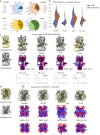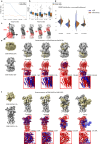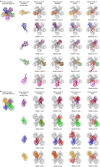Accurate global and local 3D alignment of cryo-EM density maps using local spatial structural features
- PMID: 38383438
- PMCID: PMC10881975
- DOI: 10.1038/s41467-024-45861-4
Accurate global and local 3D alignment of cryo-EM density maps using local spatial structural features
Abstract
Advances in cryo-electron microscopy (cryo-EM) imaging technologies have led to a rapidly increasing number of cryo-EM density maps. Alignment and comparison of density maps play a crucial role in interpreting structural information, such as conformational heterogeneity analysis using global alignment and atomic model assembly through local alignment. Here, we present a fast and accurate global and local cryo-EM density map alignment method called CryoAlign, that leverages local density feature descriptors to capture spatial structure similarities. CryoAlign is a feature-based cryo-EM map alignment tool, in which the employment of feature-based architecture enables the rapid establishment of point pair correspondences and robust estimation of alignment parameters. Extensive experimental evaluations demonstrate the superiority of CryoAlign over the existing methods in terms of both alignment accuracy and speed.
© 2024. The Author(s).
Conflict of interest statement
The authors declare no competing interests.
Figures






Similar articles
-
CryoAlign2: efficient global and local Cryo-EM map retrieval based on parallel-accelerated local spatial structural features.Bioinformatics. 2025 May 6;41(5):btaf296. doi: 10.1093/bioinformatics/btaf296. Bioinformatics. 2025. PMID: 40347456 Free PMC article.
-
Deep Learning for Validating and Estimating Resolution of Cryo-Electron Microscopy Density Maps †.Molecules. 2019 Mar 26;24(6):1181. doi: 10.3390/molecules24061181. Molecules. 2019. PMID: 30917528 Free PMC article.
-
VESPER: global and local cryo-EM map alignment using local density vectors.Nat Commun. 2021 Apr 7;12(1):2090. doi: 10.1038/s41467-021-22401-y. Nat Commun. 2021. PMID: 33828103 Free PMC article.
-
Toward Compositional Contrast by Cryo-STEM.Acc Chem Res. 2021 Oct 5;54(19):3621-3631. doi: 10.1021/acs.accounts.1c00279. Epub 2021 Sep 7. Acc Chem Res. 2021. PMID: 34491730 Review.
-
Refinement of Atomic Structures Against cryo-EM Maps.Methods Enzymol. 2016;579:277-305. doi: 10.1016/bs.mie.2016.05.033. Epub 2016 Jun 24. Methods Enzymol. 2016. PMID: 27572731 Review.
Cited by
-
CryoAlign2: efficient global and local Cryo-EM map retrieval based on parallel-accelerated local spatial structural features.Bioinformatics. 2025 May 6;41(5):btaf296. doi: 10.1093/bioinformatics/btaf296. Bioinformatics. 2025. PMID: 40347456 Free PMC article.
-
Advancing structure modeling from cryo-EM maps with deep learning.Biochem Soc Trans. 2025 Feb 7;53(1):259-65. doi: 10.1042/BST20240784. Biochem Soc Trans. 2025. PMID: 39927816 Free PMC article. Review.
References
Grants and funding
LinkOut - more resources
Full Text Sources

